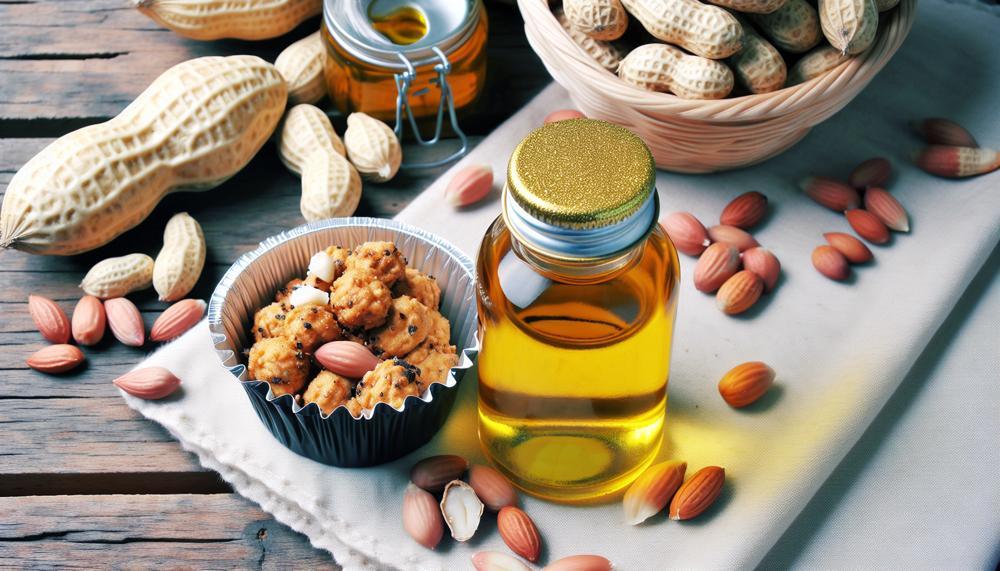Imagine the smell of freshly fried chicken, golden and crispy, wafting through your kitchen.
You take a bite and savor the perfectly seasoned meat, cooked to perfection in peanut oil. But as you reach for another piece, a thought crosses your mind – when does peanut oil go bad?
Unopened peanut oil can last 1–2 years past its expiration date if stored in a cool, dark place. Once opened, it should be used within 6 months. To extend its shelf life by a few months, you can store it in the refrigerator.
So, let’s get started.
Contents
What Is Peanut Oil?
Peanut oil is a versatile cooking oil with a high smoke point, mild taste, and numerous heart-healthy advantages.
There are two main types: gourmet roasted and refined. Gourmet roasted peanut oil is considered a specialty oil because it is rich in vitamin E and phytosterols, while refined peanut oil undergoes a process to remove allergenic proteins and is commonly used for frying.
Both types are free of trans fats and cholesterol, and have low levels of saturated fats. High oleic peanut oil is the healthier choice for frying as it can withstand higher temperatures without leaving behind residue on food.
When stored properly, peanut oil has a shelf life of up to one year, but frequent use of small amounts can extend its shelf life even longer. It should be stored in a cool, dark place and tightly sealed to prevent air from entering and causing spoilage.
Be sure to check for signs of spoilage before using peanut oil in your dishes, such as a darkened color, rancid smell, or bitter and sour taste, as these can cause food poisoning if consumed.
So, Does Peanut Oil Go Bad?
There are several key indicators that your peanut oil may have gone bad and is no longer suitable for consumption. These include a putrid or rancid odor, an unusual or bitter taste, a significant change in color, the presence of foam on the surface, and a darker or cloudy appearance.
If your peanut oil smells like seafood or has a musty scent, this is also an indication that it has gone bad and should not be used.
Additionally, if the oil has a yellowish or grayish hue, or if it tastes sour or differs from its usual taste, it is likely to be spoiled.
If you are unsure whether your peanut oil has gone bad, it is always better to err on the side of caution and dispose of it rather than risk consuming spoiled oil.
Using spoiled oil can lead to food poisoning and other health issues.
Therefore, regularly checking for signs of spoilage and properly storing your peanut oil is necessary to ensure its longevity and safety for consumption.
How To Tell When Peanut Oil Is Bad?
There are a few visual and olfactory clues that can help you determine if your peanut oil has gone bad.
These include changes in color, cloudiness, and an unpleasant odor.
Changes in Color:

Fresh peanut oil typically has a clear golden hue. However, if it starts to darken or become cloudy, it is a clear sign that the oil has gone bad.
This is due to oxidation, where the oil reacts with oxygen and other substances in the air, causing it to spoil.
Cloudiness:
Another visual indicator of spoiled peanut oil is cloudiness. If the oil appears hazy or has particles floating in it, it’s best to toss it out. This could be a sign of bacterial growth, which can make the oil unsafe for consumption.
Unpleasant Odor:
Fresh peanut oil usually has a neutral scent. But if it starts to emit a rancid or sour smell, this is a clear indication that it has gone bad.
Similar to changes in color, this is also caused by oxidation, which produces compounds that give off an offensive odor.
It’s important to keep in mind that these visual and olfactory indicators may not always be present in spoiled peanut oil.
Therefore, it’s also essential to check the taste before using it for cooking.
In conclusion, changes in color, cloudiness, and an unpleasant odor are key indicators that peanut oil has turned bad.
By regularly checking for these signs and properly storing the oil, you can ensure its freshness and safety for consumption.
How To Properly Store Peanut Oil?
| Proper Storage Method | Description |
| Cool and Dark Place is Key | Peanut oil should be stored in a cool, dry place away from direct sunlight and sources of heat. Exposure to light and heat can cause the oil to oxidize and go bad. |
| Seal the container tightly | Make sure the cap or lid of the container is securely sealed to prevent air from entering and causing spoilage. |
| For long-term freshness, refrigerate | If you plan on storing peanut oil for more than a year, it’s best to keep it in the refrigerator. This will slow down the oxidation process and extend its shelf life. |
| Small amounts, frequent use | Using small amounts of peanut oil regularly can help prolong its shelf life compared to infrequent use of large amounts. This is because every time the bottle is opened, air enters and accelerates the oxidation process. |
| Keep an eye out for spoilage | To determine if peanut oil has gone bad, check its appearance, smell, and taste. If it has a darker color, rancid smell, or bitter taste, it’s best to discard it. |
Did you know that storing peanut oil properly is crucial for maintaining its freshness? As a writer and chef, I have learned through personal experience that using high-quality ingredients is essential for creating delicious dishes. Peanut oil is no exception. It adds a nutty flavor and a high smoke point to any recipe, making it a staple in many kitchens.
However, if not stored correctly, peanut oil can quickly go bad and ruin the taste of your dishes. To prevent this from happening, here are some expert storage tips to follow:
| Proper Storage Method | Description |
| Avoid direct sunlight and heat | Peanut oil should be stored in a cool, dry place away from direct sunlight and sources of heat. This exposure can cause the oil to oxidize and turn rancid. |
| Securely seal the container | Make sure the cap or lid of the container is tightly sealed to prevent air from entering and causing spoilage. |
Can You Freeze Peanut Oil?
The answer is yes, but there are a few things to keep in mind before freezing.
First and foremost, it is important to check the quality of the oil before freezing. Expired or rancid oil should not be frozen or consumed. If the oil has a foul smell or taste, it is best to discard it. Freezing will not make bad oil edible.
Next, when storing peanut oil in the freezer, make sure to use an airtight container. This will prevent any moisture or air from getting in and causing the oil to go rancid or develop freezer burn. It is also recommended to freeze the oil in smaller containers or freezer bags rather than one large container. This makes it easier to thaw and reduces exposure to air and moisture.
When ready to use the frozen peanut oil, it is best to thaw it slowly in the refrigerator. This helps maintain the quality of the oil and prevents it from going rancid. Once thawed, the oil can be stored in the refrigerator for up to 6 months before needing to be discarded.
It is important to note that freezing does not kill any bacteria present in the oil. If the oil was contaminated before freezing, it will still be unsafe to consume after thawing. Additionally, repeatedly freezing and thawing can affect the quality and flavor of the oil. It is best to only freeze what is needed and use it within a reasonable time frame.
How To Defrost Frozen Peanut Oil?
If you’re wondering how to safely defrost frozen peanut oil while maintaining its quality, here’s a step-by-step guide:
Thaw the oil gradually
The most effective way to thaw frozen peanut oil is by letting it defrost slowly at room temperature.
This may take a few hours, but it helps prevent potential health risks associated with rapid temperature changes.
Use natural heat sources or warm water
If you need to defrost the oil quickly, you can place the container in direct sunlight or submerge it in a bowl of warm water.
However, avoid using hot water as it may cause the oil to heat up and potentially spoil.
Avoid heating the oil
It’s important not to heat frozen peanut oil to defrost it as it can be dangerous.
Heating the oil can cause the water content to evaporate rapidly, leading to a steam explosion.
Do not refreeze
Once peanut oil has been thawed, do not refreeze it as it can affect its quality and increase the risk of foodborne illnesses.
Check for spoilage
After thawing, check the appearance, smell, and taste of the oil before using it.
If it has a dark color, rancid odor, or bitter taste, discard it as it may have gone bad.
Strain before use
If you plan on reusing the thawed peanut oil for frying, make sure to strain it through a fine-mesh sieve to remove any food debris that may have accumulated during the freezing process.
To better understand how to safely defrost frozen peanut oil, refer to the table below:
| Step | Method | Benefits/Notes |
| 1 | Thaw gradually at room temperature | – Reduces potential health risks – Maintains oil quality |
| 2 | Use natural heat sources or warm water | – Quickens thawing process – Avoid using hot water to prevent oil from heating up |
| 3 | Avoid heating the oil | – Heating can cause a steam explosion – Dangerous and can affect oil quality |
| 4 | Do not refreeze | – Refreezing can affect oil quality and increase risk of foodborne illnesses |
| 5 | Check for spoilage before use | – Appearance, smell, and taste can indicate if the oil has gone bad – Discard if it has a dark color, rancid odor, or bitter taste |
The Best Way To Dispose Of Peanut Oil
The safest and most effective method for disposing of peanut oil is to first allow it to cool completely after use. It is crucial to ensure that the oil has reached a safe temperature before handling, as hot oil can be extremely hazardous without proper safety precautions.
Once cooled, carefully pour the oil into a non-breakable and tightly sealed container, such as a discarded can, plastic bottle, or coffee can. This will prevent any potential spills or accidents during disposal.
Then, simply throw away the container with your regular trash.
It should be noted that peanut oil should never be poured down the drain as it can cause blockages and damage to your plumbing system. Moreover, disposing of large amounts of peanut oil can contaminate soil and water sources, which is harmful to the environment.
For those looking for an eco-friendly option, recycling peanut oil is a great alternative. Some cities have specific programs in place for recycling cooking oils, including peanut oil. Contact your local sanitation office to inquire about this service and carefully follow their instructions for proper disposal.
If recycling is not available, you can still reuse peanut oil for future cooking purposes. However, before reusing, it is essential to strain the oil through a sieve to remove any food particles or debris that may have accumulated. This will not only prolong the life of the oil but also prevent any unpleasant flavors in your dishes.
Don’t Let Rancid Peanut Oil Spoil Your Dinner.
Peanut oil is a common ingredient in many kitchens and known for its delicious flavor that can elevate any dish. However, like all oils, it has a shelf life and can go bad over time, potentially ruining your meal.
So, how can you tell if your peanut oil has gone bad and is safe to use? Here are some tips to help you determine the quality of your peanut oil and avoid any culinary disasters.
Check the appearance:
The first indication that your peanut oil may have gone bad is a change in its appearance. Fresh peanut oil should have a shiny, golden color.
If you notice that the oil has turned cloudy or has a dark color, it is most likely spoiled and should not be used.
Take a whiff:
Another way to assess the quality of your peanut oil is by its smell. Rancid oils have a distinct unpleasant odor, often described as musty or fishy.
If your oil smells off or has a chemical-like smell, it’s best to avoid using it in cooking.
Give it a taste:
While not the most appetizing thing to do, tasting the oil can help determine its quality.
If your peanut oil has a bitter, sharp, or off taste, it’s most likely rancid and should not be consumed.
Do the freezer test:
A simple way to check if your peanut oil is still good is by doing the freezer test. Pour some oil into a glass dish and place it in the freezer for 30 minutes. After 30 minutes, take out the dish and let it sit at room temperature for another 10 minutes.
If the oil has separated into two layers and has an unpleasant smell, then it’s time to throw it away.
Look for foam or discoloration:
If you’re unsure about the quality of your peanut oil, look for any foam on the surface or dip a glass measuring cup in the oil and hold it up to the light.
If there is foam or if the oil has a darker color than when you first purchased it, it’s most likely not safe to use.
Also Read: How Can You Tell If Squash Is Bad?
Conclusion
In conclusion, peanut oil is a beloved cooking staple renowned for its rich flavor and versatility. But even the best things have an expiration date. To make the most out of your peanut oil, proper storage is crucial. Keep it in a cool, dark place and tightly sealed container to extend its shelf life.
Regularly checking for signs of spoilage and using small amounts frequently can also help maintain its freshness. With proper storage, peanut oil can last up to one year or even longer.
However, if you notice a rancid odor, change in color, or cloudiness in your peanut oil, it’s time to say goodbye. These are clear indications that the oil has gone bad and using it can lead to food poisoning and other health issues.




